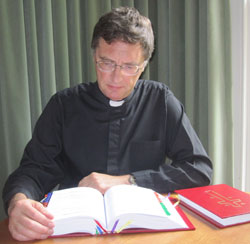
I’m grateful to regular commenter here, Deacon Chris Sullivan, who pointed to the statement from the New Zealand [Roman Catholic] bishops welcoming Pope Francis’ edict on translations of liturgical texts.
For those not (fully) up to speed on this, let’s just recap:
Liturgiam authenticam was promulgated by the Vatican in 2001. It had a very strict word-for-word translation rule and resulted in an English-language translation of the Roman Missal from Latin into English as it is not used, the loss of ecumenically-agreed texts, and hence our shared musical tradition. There have, of course, been positives too. The new translation did, for example, help my discovery that Anglicans (Episcopalians) and Roman Catholics share the same collect collection. And that we often pray these on the same day (a practice no one has yet provided a history or explanation of)!
In September, Pope Francis issued a motu proprio, Magnum Principium (The Great Principle). This changes Canon 838 on translating liturgy into the vernacular.
Until this change, bishops’ conferences would make suggestions to the Vatican, but it was the Vatican that made all the ultimate calls and changes to the English translation. That, of course, was not the teaching of Vatican II which gave far more weight to the local bishops. Pope Francis has now reformed the process, handing back the responsibility to the bishops in accordance with this Vatican II vision.
In a most helpful document in which Pope Francis corrects Cardinal Sarah on translation, and thereby expands the understanding of the Pope’s motu proprio, Pope Francis has three dimensions rightly involved in translation. The Pope sees
a threefold fidelity: in primis, to the original text;
then to the particular language in which it is translated,
and finally to the comprehension of the text by the recipients.
New Zealand Bishop Charles Drennan (Palmerston North) has an excellent analysis (his whole article is worth reading).
The new translation of the Mass is six years old. Notwithstanding the introduction of some evocative language, its clunky sentence construction and often awkward vocabulary have tested us all.
…Pope Benedict’s love for liturgy saw him underline the duty to preserve a sense of the transcendent and reverence. Pope Francis’s love for liturgy sees him underline that liturgy must be comprehensible and should be understood in the context of evangelization, which draws people in as participants, not observers, of the liturgy. Both are right.
Liturgiam authenticam in fact unfolded as a hindrance not a facilitation of Benedict’s intentions. The 2010 English translation of the Mass burdened rather than enhanced the beauty of the English language’s concise syntax, by imposing a Latin sentence structure. … A good translation is one whereby the reader assumes the text is the original.
Pope Francis has pushed the pendulum back from the more recent Roman Catholic tendency for increased international centralisation (a tendency also evident recently within the Anglican Communion) towards the appropriateness of the principle of subsidiarity.
New Zealand’s Roman Catholic bishops make an important statement and bold promise (are there other English-language Episcopal Conferences so striking?):
Like many priests and parishioners, we share in the frustration concerning some aspects of the current translation of the Roman Missal and we reiterate our desire for beauty, comprehensibility and participation in and through the sacred liturgy.
We will be working in collaboration with English speaking Bishops’ Conferences around the world, as we seek to explore prudently and patiently the possibility of an alternative translation of the Roman Missal and the review of other liturgical texts.
Encouraged by New Zealand’s Roman Catholic bishops, I will share my own bold vision:
That Anglicans and Roman Catholics (and others interested) work together to produce English language translations that can, as much as possible, be used by anyone in those denominations.
I visualise Anglicans and Roman Catholics (who currently essentially use the same readings at the Eucharist) using the exact same collect with the exact same wording on the same day, using the same responses, translation of the Kyrie, Gloria, Creed, Sanctus, Agnus Dei, and other texts… even using the same wording for the Eucharistic Prayer.
I hope the New Zealand Anglican and Roman Catholic bishops (who meet together regularly) take up the energy manifest in The New Zealand Catholic Bishops Conference statement and see if such a vision might get some legs. I will forward this idea to Patrick Dunn, Bishop of Auckland and New Zealand Catholic Bishops Conference President, and Philip Richardson, Anglican Archbishop of New Zealand.
I think it is unclear whether there would be a new English translation that would be the same across the whole English-speaking world. I wonder if other English speaking Bishops’ Conferences and the corresponding local Anglican province might join such a new and exciting ecumenical venture.
What do you think?
If you appreciated this post, do remember to like the liturgy facebook page, use the RSS feed, and sign up for a not-very-often email, …




I think your proposal is excellent Bosco, and very much in the spirit of receptive ecumenism, where the ecumenical partners share their own gifts and receive the gifts of others with joy. Anglicans have a magnificent capacity to express liturgy in beautiful English and Catholics can offer the gifts of tradition and theological precision.
Together we could do much better than we could do on our own.
We need to keep moving forward together towards full unity, and I think this would be a very helpful step along the way.
I wonder how it would work wrt the many options now available in the local Anglican liturgy (the “Church of Or”) ? Presumably those would remain ?
Many Blessings
Thanks for the encouragement, Chris. I’ve also already received encouragement from liturgical scholars overseas.
As I wrote to Bishop Patrick and Archbishop Philip:
It is not for me to predict how this might work in detail, but, as you indicate, this could be an option – the quality of what is produced (as is often the case historically with liturgy) may encourage its use [just as, for example, some RC Eucharistic Prayers (or other options) may be more used than others].
Blessings.
It would be quite good if we prayed the same version of the Lord’s Prayer (in English and in Te Reo!)
Yes, Peter. That’s a good example. We had that (in English) in some places in NZ, and permission for that was sought but then refused in the new translation. Blessings.
Such an outcome would be a wonderful eventuality were it to come to fruition, in my humble opinion, since as Christians we are called to pray together.
Even though there may still be barriers to full and visible union (whatever that may look like) the possibility of using the same prayers from week to week would be a truly edifying ‘first step’, and highlight that we actually share more in common than many think.
Yes, Fr Andrew. Alongside reading the same readings (with which we all regularly now swap resources) imagine, for example, praying the same Daily Office (something we can all do together with no hint of a barrier). Blessings.
As you say, the ball is back in the court of the conferences. I would hope that English-speaking conferences would all engage ICEL in a production of a new translation of the missal so that we have an international English standard. Like you, I’d also hope there to be a reengagement with ELLC for ecumenically agreed texts. However, I’d expect that to lead to those texts being redrafted in a more conservative direction (for instance, in the way C of E Common Worship retained ‘was made man’ in the Creed against ‘became truly human’ for ‘homo factus est’ or ἐνανθρωπήσαντα).
The new translation brought back some traditions I like. The ‘opening prayer’ was renamed the ‘collect’. The traditional Roman tones were reintroduced, replacing the modernised ones that were an early French Catholic experiment in vernacular liturgy. I’m sure there are some that miss those tones, but I think ICEL’s work on refitting traditional tones for English texts is one of its most successful and underappreciated works, and worthy of being picked up by Anglicans.
Thanks, Gareth.
I have already mentioned the value of improved collect translations in the more recent Missal translation, and you add other under-appreciated improvements.
I haven’t time, currently, to investigate the choices made in your example of the CofE Common Worship Nicene Creed text. Certainly “was made man” is not to be advocated. The ELLC commentary is clear:
I would balance your expectation of texts moving “in a more conservative direction” with reflections on Pope Francis’ third dimension of the “triple fidelity” of liturgical translation. This can be seen as including a comprehension that is always conditioned by their cultural context. This would require that liturgical translators take care that the texts they translate be “audible,” not only in the receptor language but also in the receptor culture. The consequences on the need for inclusiveness in our English-language cultures is an important exploration.
Blessings.
Father B, what did English-speaking RCs use prior to the stilted translation enforced more recently? Did they all use the same English translation before (allowing for spelling conventions)? Is that still available?
If still available, it would seem a good place to begin and it would seem good that all English-speaking conferences threw in together. Less expensive than everyone reinventing the wheel on their own.
Mis dos centavos.
Yes, David. The English-speaking RC translation became available (soon) after Vatican II (1973) and was the same throughout the world. I’m sure it is still on the shelves and cupboards around the world (and in the heads of those who have more recently stopped going to church). There was also a translation produced in 1998 which was rejected by the Vatican. Blessings.
Do have a look at the 1998 translation: it was a graceful and reader-friendly version and a great improvement on the often banal and trite first English RC translation of the liturgy. It had the support of most English-speaking Bishops’conferences before it was vetoed by Rome. It is ready made for the economies of scale that would come from universal adoption. Unfortunately the English Bishops do not seem to be interested but perhaps the New Zealand Bishops might take the lead. Yet i doubt in the end Anglicans will want to give up the unique riches of their own tradition as first formulated by the incomparable work of Cramner.
Thanks, Tim. I regularly refer to the 1998 translation on this site. Where would you suggest people get hold of this version? Blessings.